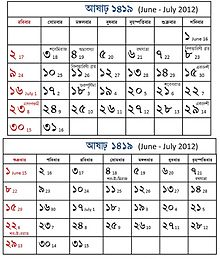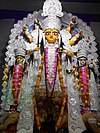|
Bengali calendar
The Bengali Calendar (Bengali: বঙ্গাব্দ, romanized: Bôṅgābdô, colloquially বাংলা সন, Bāṅlā Sôn or বাংলা সাল, Bāṅlā Sāl, "Bangla Year"),[1] is a solar calendar[2] used in the Bengal region of the South Asia. A revised version of the calendar is the national and official calendar in Bangladesh and an earlier version of the calendar is followed in the Indian states of West Bengal, Tripura and Assam. Unlike the traditional Indian Hindu calendar which starts with the month of Choitro, the Bengali calendar starts with Boishakh because of the reforms made during the reign of the Mughal Emperor Akbar in Mughal Bengal. The first day of the Bengali year is known as Pohela Boishakh (1st of Boishakh) which is a public holiday in Bangladesh.[3] The Bengali era is called Bengali Sambat (BS)[4] and has a zero year that starts in 593/594 CE. It is 594 less than the AD or CE year in the Gregorian calendar if it is before Pohela Boishakh, or 593 less if after Pohela Boishakh. HistoryThe Saka Era was the widely used in Bengal, prior to the arrival of Muslim rule in the region, according to various epigraphical evidence.[5][6] The Bikrami calendar was in use by the Bengali people of the region. This calendar was named after king Vikramaditya with a zero date of 57 BCE.[7] In rural Bengali communities, the Bengali calendar is credited to "Bikromaditto", like many other parts of India and Nepal. However, unlike these regions where it starts in 57 BCE, the modern Bangladeshi and Bengali calendar starts from 593 CE suggesting that the starting reference year was adjusted at some point.[8][9] Buddhist/Hindu influenceSome historians attribute the Bengali calendar to the 7th century Bengali king Shashanka, whose reign covered the Bengali era of 594 CE.[10][11][1] The term Bangabda (Bangla year) is found too in two Shiva temples many centuries older than Akbar era, suggesting that a Bengali calendar existed long before Akbar's time.[1] Hindus developed a calendar system in ancient times.[12] Jyotisha, one of the six ancient Vedangas,[13][14] was the Vedic era field of tracking and predicting the movements of astronomical bodies in order to keep time.[13][14][15] The ancient Indian culture developed a sophisticated time keeping methodology and calendars for Vedic rituals.[12] The Hindu Vikrami calendar is named after king Vikramaditya and starts in 57 BC.[16] In rural Bengali communities of India, the Bengali calendar is credited to "Bikromaditto", like many other parts of India and Nepal. However, unlike these regions where it starts in 57 BC, the Bengali calendar starts from 593 suggesting that the starting reference year was adjusted at some point.[8][9] Various dynasties whose territories extended into Bengal, prior to the early 13th-century, used the Vikrami calendar. For example, Buddhist texts and inscriptions created in the Pala Empire era mention "Vikrama" and the months such as Ashvin, a system found in Sanskrit texts elsewhere in ancient and medieval Indian subcontinent.[17][18] Hindu scholars attempted to keep time by observing and calculating the cycles of the Sun (Surya), Moon, and the planets. These calculations about the Sun appear in various Sanskrit astronomical texts in Sanskrit, such as the 5th century Aryabhatiya by Aryabhata, the 6th century Romaka by Latadeva and Panca Siddhantika by Varahamihira, the 7th century Khandakhadyaka by Brahmagupta and the 8th century Sisyadhivrddida by Lalla.[19] These texts present Surya and various planets and estimate the characteristics of the respective planetary motion.[19] Other texts such as Surya Siddhanta dated to have been complete sometime between the 5th century and 10th century.[19] The current Bengali calendar in use by Bengali people in the Indian states such as West Bengal, Tripura, Assam and Jharkhand is based on the Sanskrit text Surya Siddhanta and includes the modifications introduced during the reign of Shashanka, the first independent ruler of Gauda. The timeline Shashanka becoming the sovereign ruler of Bengal rising from a territorial ruler matches with the first year of Bangabda. It retains the historic Sanskrit names of the months, with the first month as Baishakh.[10] Their calendar remains tied to the Hindu calendar system and is used to set the various Bengali Hindu festivals.[10] Influence of Islamic CalendarAnother theory is that the calendar was first developed by Alauddin Husain Shah (reign 1494–1519), a Hussain Shahi sultan of Bengal by combining the lunar Islamic calendar (Hijri) with the solar calendar, prevalent in Bengal.[1] Yet another theory states that the Sasanka calendar was adopted by Alauddin Husain Shah when he witnessed the difficulty with collecting land revenue by the Hijri calendar.[1] During the Mughal rule, land taxes were collected from Bengali people according to the Islamic Hijri calendar. This calendar was a lunar calendar, and its new year did not coincide with the solar agricultural cycles. The current Bengali calendar owes its origin in Bengal to the rule of Mughal Emperor Akbar who adopted it to time the tax year to the harvest. The Bangla year was therewith called Bangabda. Akbar asked the royal astronomer Fathullah Shirazi to create a new calendar by combining the lunar Islamic calendar and solar Hindu calendar already in use, and this was known as Fasholi shan (harvest calendar). According to some historians, this started the Bengali calendar.[10][20] According to Shamsuzzaman Khan, it could be Nawab Murshid Quli Khan, a Mughal governor, who first used the tradition of Punyaho as "a day for ceremonial land tax collection", and used Akbar's fiscal policy to start the Bangla calendar.[11][21] It is unclear whether it was adopted by Hussain Shah or Akbar. The tradition to use the Bengali calendar may have been started by Hussain Shah before Akbar.[1] According to Amartya Sen, Akbar's official calendar "Tarikh-ilahi" with the zero year of 1556 was a blend of pre-existing Hindu and Islamic calendars. It was not used much in India outside of Akbar's Mughal court, and after his death the calendar he launched was abandoned. However, adds Sen, there are traces of the "Tarikh-ilahi" that survive in the Bengali calendar.[22] Regardless of who adopted the Bengali calendar and the new year, states Sen, it helped collect land taxes after the spring harvest based on traditional Bengali calendar, because the Islamic Hijri calendar created administrative difficulties in setting the collection date.[1] The government and newspapers of Bangladesh widely use the term Bangla shal (B.S.). For example, the last paragraph in the preamble of the Constitution of Bangladesh reads "In our Constituent Assembly, this eighteenth day of Kartick, 1379 B.S., corresponding to the fourth day of November, 1972 A.D., do hereby adopt, enact and give to ourselves this Constitution."[23] The zero year in the Bangladeshi calendar era is 593 CE.[22][8][9][24] Shamsuzzaman Khan wrote, "that it is called Bangla san or saal, which are Arabic and Parsee words respectively, suggests that it was introduced by a Muslim king or sultan."[11] In contrast, according to Sen, its traditional name is Bangabda.[1][25] In the era of the Akbar, the calendar was called as Tarikh-e-Elahi (তারিখ-ই ইলাহি). In the "Tarikh-e-Elahi" version of the calendar, each day of the month had a separate name, and the months had different names from what they have now. According to Banglapedia, Akbar's grandson Shah Jahan reformed the calendar to use a seven-day week that begins on Sunday, and the names of the months were changed at an unknown time to match the month names of the existing Saka calendar.[26] This calendar is the foundation of the calendar that has been in use by the people of Bangladesh.[2][26][1] Calendar structureThe Bengali calendar used in Bangladesh is a solar calendar[2][26] and the one used in India is a lunisolar calendar. Months
DaysThe Bengali Calendar incorporates the seven-day week as used by many other calendars. The names of the days of the week in the Bengali Calendar are based on the Navagraha (Bengali: নবগ্রহ nôbôgrôhô). The day begins and ends at sunrise in the Bengali calendar, unlike in the Gregorian calendar, where the day starts at midnight. According to some scholars, in the calendar originally introduced by Akbar in the year 1584 AD, each day of the month had a different name, but this was cumbersome, and his grandson Shah Jahan changed this to a 7-day week as in the Gregorian calendar, with the week also starting on a Sunday.[26]
Traditional and revised versions The current Bengali calendar in the Indian states is based on the Sanskrit text Surya Siddhanta. It retains the historic Sanskrit names of the months, with the first month as Baishakh.[10] Their calendar remains tied to the Hindu calendar system and is used to set the various Bengali Hindu festivals.[10] In Bangladesh, however, the old Bengali calendar was modified in 1966 by a committee headed by Muhammad Shahidullah, making the first five months 31 days long, the rest 30 days each, with the month of Falgun adjusted to 31 days in every leap year.[10] This was officially adopted by Bangladesh in 1987.[10][26] FestivalsThe following lists major festivals on the Bangladeshi calendar. Pohela BoishakhThe first day of the month of Boishakh ushers the Bengali New Year and is known as Pohela Boishakh. The festival is similar to New Year's Day, Nowruz and Songkran. In Dhaka, the cultural organization Chhayanaut hosts a notable concert in Ramna Park, starting at dawn on 14 April. The Mangal Shobhajatra parades are brought out in many Bangladeshi cities during the festival and is regarded by UNESCO as an intangible cultural heritage.[citation needed] The Bengali New Year's Day is a national holiday in Bangladesh and Indian state of West Bengal, observed on 14 and 15 April on each region, respectively.[citation needed] Haal KhataTraders start a new Haal Khata book on Pohela Boishakh to keep financial records and settle debts.[29] Boishakhi MelaThe Boishakhi Mela are fairs organized on Pohela Boishakh.[29] Spring festivalPohela Falgun and Basanta Utsab is the first day of spring in the Bengali calendar celebrated in Bangladesh and India, respectively.[citation needed] Boli KhelaIn the Chittagong region of Bangladesh, the Boli khela wrestling matches are organized during the month of Boishakh.[29] Cattle racingCattle races are a popular activity in Manikganj and Munshiganj districts of Bangladesh during Boishakh.[29] See also
References
Bibliography
External links
|
|||||||||||||||||||||||||||||||||||||||||||||||||||||||||||||||||||||||||||||||||||||||||||||||||||||||||||||||||||||||||||||||||||||||||||||||||||||||||||||||||||||||||||||||||||||||||||||



